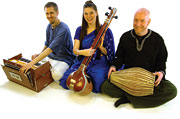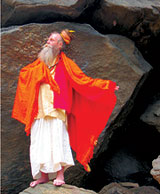
Local kirtan group Sangita Devi performs with traditional Indian instruments.
|
“What we’re doing, by playing on a weekly basis, is: We’re holding a torch here,” explains local yoga instructor Timothy Burgin. He’s talking about his Tuesday night engagement with kirtan group Sangita Devi, a collective of musicians who lead devotional chants in Sanskrit.
“Then, when a big national act comes [to town], we totally support them,” Burgin continues. “We usually play with them. We want Jai Uttal to come here, because we love him and we love kirtan.”
In kirtan terms, Jai Uttal is like Mick Jagger. Now try to to imagine a local band saying, “Oh, we don’t mind if the Stones come to town and sell out the Civic Center; we’re just here holding down the scene until the big names show up.”
But kirtan—even as the American movement picks up steam and prominent chant leaders emerge—remains steadfastly rooted in a spirit of community and sharing. Burgin points out, “With kirtan, it’s hard to have an ego. We’re all just singing together. We all have our eyes closed; you can’t really hear what your neighbor is doing.”
Still, Americanized kirtan packs a pop-culture punch. Web site Groovananda.com has branded one beat-box-heavy exposition of the genre “Kirtana Americana.”
Love for love’s sake

Bhagavan Das, one of the central figures in Ram Dass’ Be Here Now, returns to Asheville.
|
“The community of kirtan sustains us through the week,” says Sangita Devi leader Renjith. “It invigorates me, it refreshes me.”
Samata, another member of Sangita Devi, adds, “Kirtan is my church. Bhakti yoga is the path of devotion, the path of the heart. I feel that in a more real way [through kirtan] than I’ve ever experienced in church.”
Yoga, a family of ancient practices from India, deals with far more than performing pretzel poses in stretchy pants. In fact, asanas—the poses performed in yoga studios—are a minor part of yoga as a whole.
According to Sri Swami Shivananda, “The term Bhakti comes from the root ‘Bhaj,’ which means ‘to be attached to God’ … Bhakti is love for love’s sake. The devotee wants God and God alone.”
Kirtan, as defined by Wikipedia, “is one of the pillars of Sikhism and in that context refers to the singing of the sacred hymns from the Guru Granth Sahib to set music normally in classical Raags format.” However, the name is often used in place of the term “bhajan,” which refers to Hindu devotional song.
In the 1960s, Americans such as Dr. Richard Alpert (later known as Ram Dass, author of Be Here Now, Michael Riggs (who became Bhagavan Das) and Jeffrey Kagel (now called Krishna Das) famously traveled to India and brought back Hindu esoteric practices including kirtan. Around the same time, A.C. Bhaktivedanta Swami Prabhupada brought Hare Krishna consciousness to New York City, a movement that inspired former Beatle George Harrison to pen “My Sweet Lord,” which put the Hare Krishna mantra on the radio.
The way to a yogi’s heart is through his stomach
These days, Hare Krishna kirtans are still popular and continue to spread across the country. “We invite people to come and glorify Krishna though chanting and prayer,” says Vijaya Gopal Das, who leads the local Sunday feasts at Namaste Yoga Center. “We do a short talk from the Bhagavad Gita and socialize to show people how you can enjoy life close to God. In a couple of hours we show people how they can practice.”
Though visitors to the Sunday feasts sing and discuss Vedic literature, it’s the food that most people associate with Hare Krishnas (well, that and the shaved heads and orange robes). “We are really attached to prasad because it’s one of the most beautiful parts of the program,” Vijaya insists. Prasad is “food offered to Krishna, cooked with much love and devotion.” At a recent event, Vijaya served rice, dahl, chickpeas in masala sauce, Indian chips and halva.
The meal is free (participants are asked to donate money as they’re able), and Vijaya knows many visitors come for the Indian vegetarian cuisine rather than the chanting. “I myself joined the [Hare Krishna] movement in this way,” he admits. “I was not into the philosophy at all, but I loved the food! By coming every day, I realized these people might look a little weird, but their philosophy is very original.”
Culture club
Many American yogis take on spiritual names given to them by gurus. Sangita Devi’s musicians received their names from Mata Amritanandamayi Devi, also known as the Hugging Saint or—affectionately—Amma. Ram Dass, Bhagavan Das (who leads an evening of Kirtan at Namaste this week), Krishna Das and Jai Uttal were given their Hindu names by the Indian guru Neem Karoli Baba. The term “Das” means “servant,” so Krishna Das is the servant of Hindu deity Lord Krishna.
Musician Bhairavesh Das, who recently relocated to Asheville with his wife Jean, received his name while part of the Hare Krishna movement. “I learned kirtan in India,” he reports. “I was part of a 24-hour kirtan in Vrindavan, which is Lord Krishna’s birthplace. They’ve chanted Krishna’s name 24 hours a day for like 30 years now.”
Of that experience, Bhairavesh muses, “It’s hard to sit for four hours … [but] it’s really intoxicating. Chanting, chanting, chanting forever. You’re in a different world.”
The musician moved to Asheville with the idea of building a retreat center for like-minded people, but for now he’s busy playing with local spiritual-experimental group Arundas and collaborating with Sangita Devi. Of the American kirtan movement, Bhairavesh explains, “The style of Kirtan here is completely different [than in India]. The singing melodies [in India] are a little bit complicated for the average American to follow. If you’ve seen Indian movies, it’s like five minutes of something happening and then 10 minutes of singing and dancing. It’s in their culture—everybody sings. [In the US] the rhythms are simplified. Here, they added harmony and other instruments like djembe and guitars.”
Nationally known kirtan leader David Stringer maintains, “Though Kirtan is rooted in a very old and profoundly joyful Eastern tradition, as a Westerner, I don’t know that it is possible for me to be traditional. I can’t help but bring my own cultural biases with me.”
East meets West … meet Easts
Here’s an interesting twist: Recently Sangita Devi brought kirtan to a Hindu temple in Johnson City, TN. The participants were Indian nationals; the leaders: Caucasian.
“The first time we did it was at a professor’s house,” recalls Renjith. “You’re bringing your culture to them and you’re hoping you’re doing it in the right way.”
But most regulars at kirtan evenings find the chanting practice through yoga studios. And while kirtan is growing exponentially in urban centers like New York City, the largest group in the U.S. can be found in Milwaukee, Wis. “They have 250 people every week,” Bhairavesh says. “It’s because [kirtan leader] Ragani is a wonderful person and she just orders everybody to come to kirtan. You have no choice,” he laughs. “She infected that whole area.”



do you come to Johnson City TN?
When will you be coming back to Johnson City TN?
hey this is really a surprise to all of us here in India to see the growing popularity of Kirtan overseas… keep it up